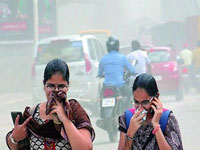
Overview of state of regulation and challenges
Presentation by Nivit Kumar Yadav of Centre for Science and Environment (CSE) at the Anil Agarwal Dialogue 2015: Poor in climate change, India Habitat Centre, New Delhi, March 11 – 12, 2015.

Presentation by Nivit Kumar Yadav of Centre for Science and Environment (CSE) at the Anil Agarwal Dialogue 2015: Poor in climate change, India Habitat Centre, New Delhi, March 11 – 12, 2015.
POLLUTION IN THE HIMALAYAS Soot gets everywhere. Even into the world's highest mountains T HE Himalayas and the adjacent Tibetan plateau are sometimes referred to as the Earth's third pole, because of the amount of ice they host. They are also known as Asia's water tower. Their glaciers feed the continent's largest rivers -and those, in turn, sustain some 1.5 billion people.

Presentation by Bhisma Pandit, Energy Auditor, Nepal at the Anil Agarwal Dialogue 2015: Poor in climate chang, India Habitat Centre, New Delhi, March 11 – 12, 2015.

Presentation by Ellen Baum of Climate and Health Research Network at the Anil Agarwal Dialogue 2015: Poor in climate change, India Habitat Centre, New Delhi, March 11 – 12, 2015.
The study estimates the health benefits to individuals from a reduction in current air pollution levels to a safe level in the Kathmandu metropolitan and Lalitpur sub-metropolitan areas of Kathmandu valley,

A recent study reveals that air pollution levels in Nepal is one of the worst among South Asian countries

Nepal and India top the list of countries with the most polluted air in the south Asian region. Hyderabad: A recent WHO Health Statistics report stated that India is the second most polluted country
India has the worst air quality in the world, beating even its neighbour China, according to an annual survey based at Yale and Columbia universities in the United States. Of all the countries surveyed
KATHMANDU, JAN 08 -Air pollution is considered to be the defining climate change issue in Nepal. To bring climate-change problems to light, an extensive talk programme was launched at the Nepal Art Council,
The Nepalese ministry of population and environment is formulating national standards for air, water and noise pollution. It will serve as a mandatory regulatory system for the entire country. The
<p>When governments develop policies, a major limiting factor is availability of sufficient information. Information often does not reach policy makers at the right time or in the form in which it is needed.
Sri Lanka's overall environmental performance is improving and the country has been ranked as a modest performer according to a study on global environment released during this year's World Economic Forum
<p>Secondary organic aerosol (SOA) affects the earth’s radiation balance and global climate. High-elevation areas are sensitive to global climate change. However, at present, SOA origins and seasonal
A rapid rise in air pollution from fossil fuels and biomass burning has worsened winter smog and extended its duration in many parts of South Asia, scientists and officials have said. In Bangladesh,

The study has found that the disease burden due to COPD was highest in Papua New Guinea, India, Lesotho, and Nepal while the burden for asthma was highest in Afghanistan, Central African Republic, Fiji,
Asia has the world's highest concentration of two and three wheelers, both in absolute terms and as a fraction of overall road vehicle population. In many Asian cities, these vehicles account for 50 to 90% of the total vehicle fleet of which a large percentage are powered by two stroke engines. The main pollutants of concern from 2-stroke three wheelers are hydrocarbons and particulate matter.

Rising pollution levels in Nepal's Kathmandu valley are a cause for concern. In a recent survey, tourists singled out air pollution as the most disturbing factor during their stay in the country.
The industries in the Bhairahawa-Lumbini road, the area along the highway between Bhairahawa and Lumbini in Rupandehi district, have a major impact on water, soil, air, flora and fauna, health and heritage
Over the past two decades the issue of air pollution in the Kathmandu Valley has become of increasing concern as concentrations of ambient air pollution exceed international air quality guidelines and standards. The steady growth in road traffic has resulted in the increasing contribution of vehicle emissions to urban air pollution, especially particulate

nepal has finally disclosed details about the air quality of its capital city, Kathmandu. Not surprisingly, the facts are worrisome. They also have wider ramifications for Nepal, which is an